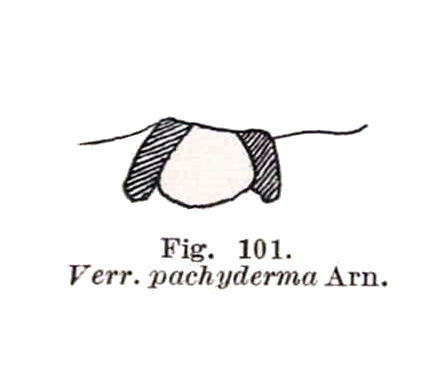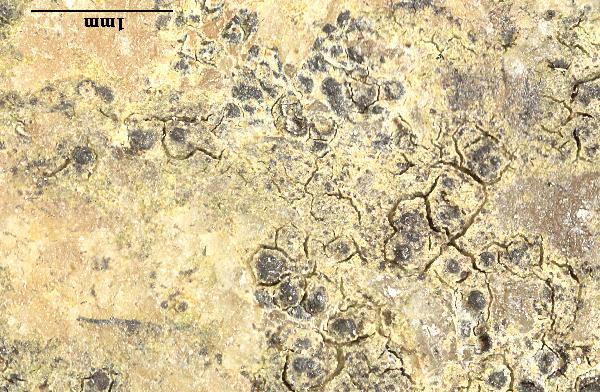Verrucaria pachyderma Arnold
Verh. zool.-bot. Ges. Wien, 30: 146, 1880.
Synonyms: Verrucaria pissina Nyl.
Description: Thallus crustose, episubstratic, subgelatinous when wet, mostly continuous, 40-200 μm thick, smooth, dull or slightly glossy, dark grey-green to blackish, sometimes with a brownish tinge, rarely delimited by a thin dark prothallus. Cortex weakly defined, with a dull green to brown-black pigment (lacking in shade-forms); algal layer paraplectenchymatous, 50-80 μm thick; medulla poorly developed, with oil cells and sometimes with a dilute brown pigment, but without a black basal layer. Perithecia immersed in thallus, not or only slightly projecting, the apex visible as a grey to black dot or ring. Involucrellum reddish brown and K+ grey, from thin and adpressed to apex of exciple to conical and spreading, sometimes reaching base-level and laterally spreading, but rarely forming a black basal layer; exciple 0.16-0.2(-0.35) mm across, the wall colourless except around the ostiole; hamathecium of up to 20 μm long periphyses and periphysoids, interascal filaments absent; hymenial gel hemiamyloid, I+ red (I+ blue at very low concentrations of I), K/I+ blue. Asci 8-spored, clavate, I-, fissitunicate, the wall thickened above, with an ocular chamber, dehiscent by extrusion of an endotunica to form a delicate rostrum, Verrucaria-type. Ascospores 1-celled, hyaline, ellipsoid to oblong-ellipsoid, (15-)17-22(-23.5) x 6-8(-9) μm, with a thin gelatinous perispore best visible in fresh material. Photobiont chlorococcoid, the cells arranged in vertical columns. Spot tests: K-, C-, KC-, P-, UV-. Chemistry: without lichen substances.
Growth form: Crustose
Substrata: rocks
Photobiont: green algae other than Trentepohlia
Reproductive strategy: mainly sexual
Periodically submerged (e.g. in creeks)
Commonnes-rarity: (info)
Alpine belt: extremely rare
Subalpine belt: very rare
Montane belt: very rare
Dry submediterranean belt: absent
Humid submediterranean belt: absent
Padanian area: absent
pH of the substrata:
1 2 3 4 5
Solar irradiation:
1 2 3 4 5
Aridity:
1 2 3 4 5
Eutrophication:
1 2 3 4 5
Poleotolerance:
0 1 2 3
Altitudinal distribution:
1 2 3 4 5 6
Rarity
absent
extremely rare
very rare
rare
rather rare
rather common
common
very common
extremely common
Loading data...
Occurrence data
Predictive map
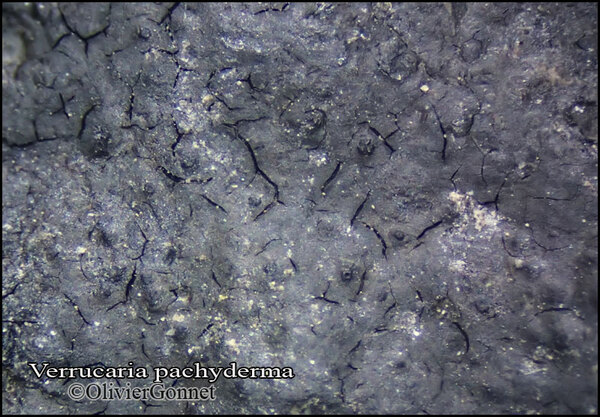
Courtesy Danièle et Olivier Gonnet - Source: https://www.afl-lichenologie.fr/Photos_AFL/Photos_AFL_V/Texte_V/Verrucaria_pachyderma.htm
France, 24/11/2011 - Asco, sous le lac d’Argent, alt. 2100 m - Corse
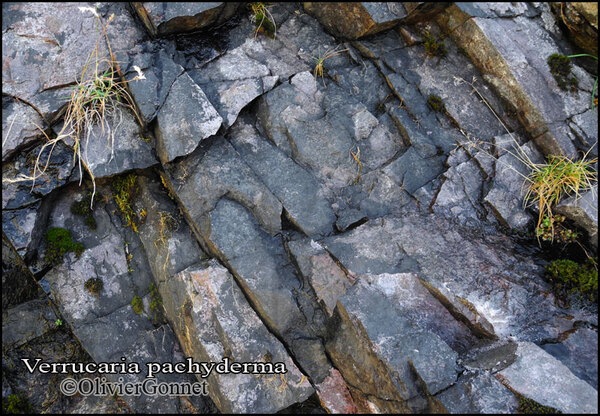
Courtesy Danièle et Olivier Gonnet - Source: https://www.afl-lichenologie.fr/Photos_AFL/Photos_AFL_V/Texte_V/Verrucaria_pachyderma.htm
France, 24/11/2011 - Asco, sous le lac d’Argent, alt. 2100 m - Corse
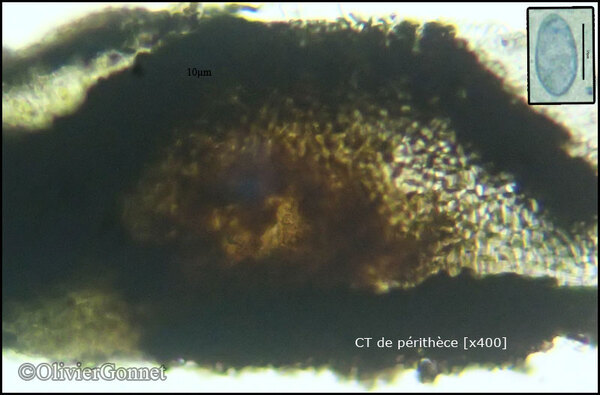
Courtesy Danièle et Olivier Gonnet - Source: https://www.afl-lichenologie.fr/Photos_AFL/Photos_AFL_V/Texte_V/Verrucaria_pachyderma.htm
France, 24/11/2011 - Asco, sous le lac d’Argent, alt. 2100 m - Corse
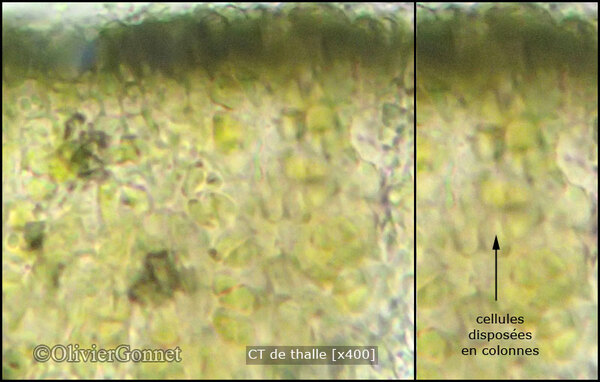
Courtesy Danièle et Olivier Gonnet - Source: https://www.afl-lichenologie.fr/Photos_AFL/Photos_AFL_V/Texte_V/Verrucaria_pachyderma.htm
France, 24/11/2011 - Asco, sous le lac d’Argent, alt. 2100 m - Corse
Growth form: Crustose
Substrata: rocks
Photobiont: green algae other than Trentepohlia
Reproductive strategy: mainly sexual
Periodically submerged (e.g. in creeks)
Commonnes-rarity: (info)
Alpine belt: extremely rare
Subalpine belt: very rare
Montane belt: very rare
Dry submediterranean belt: absent
Humid submediterranean belt: absent
Padanian area: absent
pH of the substrata:
| 1 | 2 | 3 | 4 | 5 |
Solar irradiation:
| 1 | 2 | 3 | 4 | 5 |
Aridity:
| 1 | 2 | 3 | 4 | 5 |
Eutrophication:
| 1 | 2 | 3 | 4 | 5 |
Poleotolerance:
| 0 | 1 | 2 | 3 |
Altitudinal distribution:
| 1 | 2 | 3 | 4 | 5 | 6 |
Rarity
absent
extremely rare
very rare
rare
rather rare
rather common
common
very common
extremely common
Loading data...
Occurrence data
Predictive map

Courtesy Danièle et Olivier Gonnet - Source: https://www.afl-lichenologie.fr/Photos_AFL/Photos_AFL_V/Texte_V/Verrucaria_pachyderma.htm
France, 24/11/2011 - Asco, sous le lac d’Argent, alt. 2100 m - Corse

Courtesy Danièle et Olivier Gonnet - Source: https://www.afl-lichenologie.fr/Photos_AFL/Photos_AFL_V/Texte_V/Verrucaria_pachyderma.htm
France, 24/11/2011 - Asco, sous le lac d’Argent, alt. 2100 m - Corse

Courtesy Danièle et Olivier Gonnet - Source: https://www.afl-lichenologie.fr/Photos_AFL/Photos_AFL_V/Texte_V/Verrucaria_pachyderma.htm
France, 24/11/2011 - Asco, sous le lac d’Argent, alt. 2100 m - Corse



